22+ Sample Theatre Proposal
-
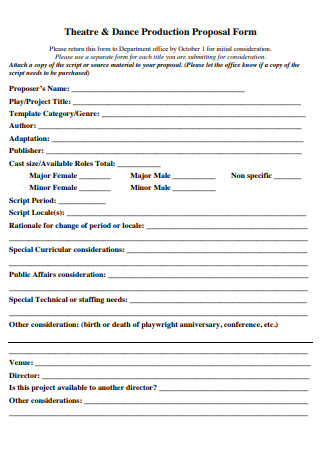
Theatre and Dance Production Proposal Form
download now -
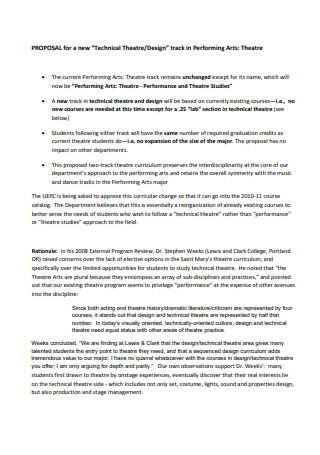
Technical Theatre Proposal
download now -
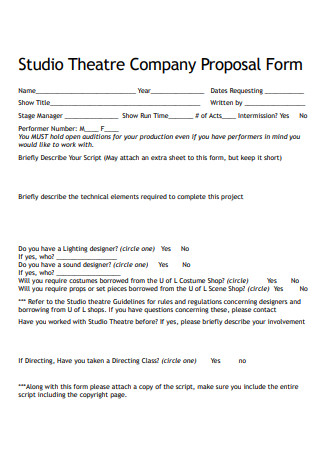
Studio Theatre Company Proposal Form
download now -
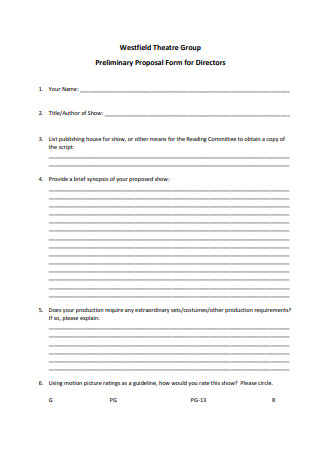
Theatre Group Preliminary Proposal Form for Directors
download now -
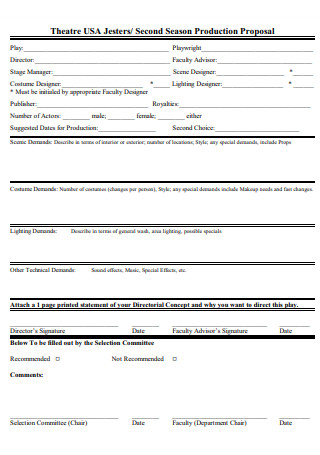
Theatre Season Production Proposal
download now -

Theatre and Performance Project Proposal
download now -
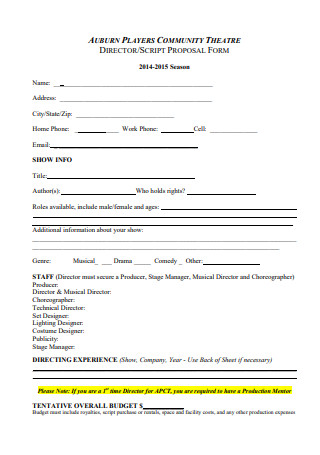
Community Theatre Script Proposal Form
download now -
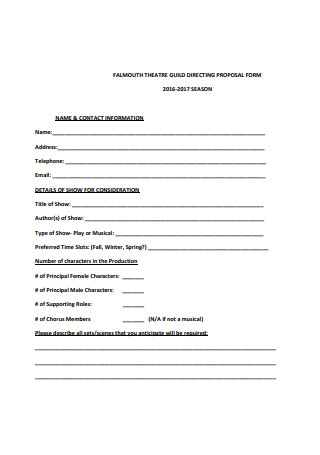
Theatre Directing Proposal Form
download now -
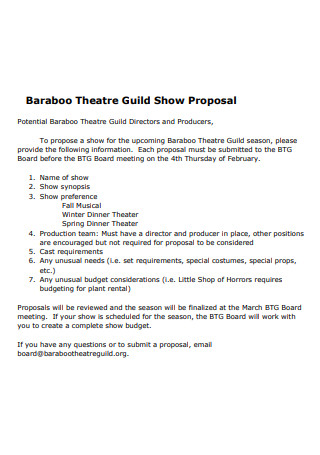
Theatre Show Proposal
download now -
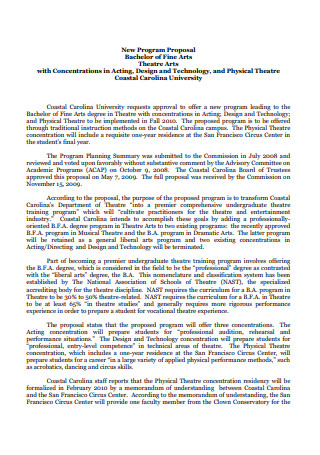
Theatre Program Proposal
download now -
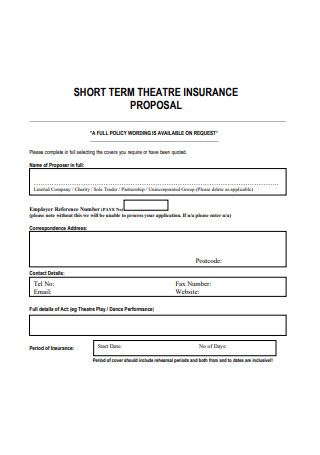
Short Term Theatre Insurance Proposal
download now -
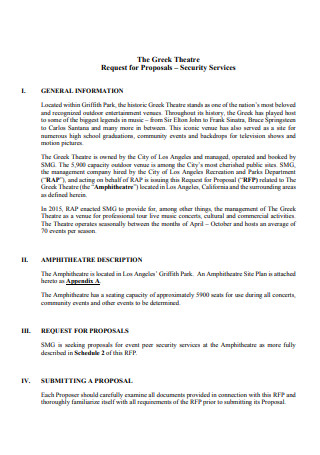
Theatre Request For Proposal
download now -
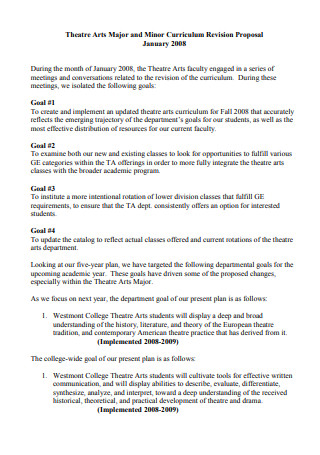
Theatre Curriculum Revision Proposal
download now -
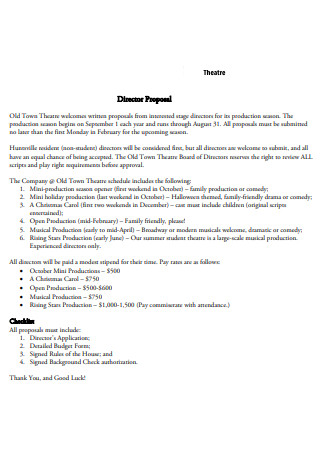
Theatre Director Proposal
download now -
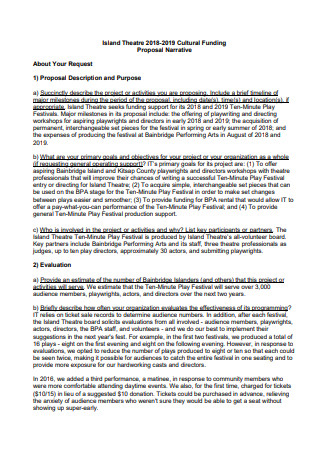
Theatre Cultural Funding Proposal
download now -
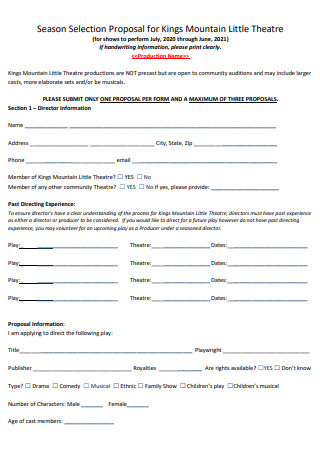
Little Theatre Season Selection Proposal
download now -

Studio Theatre Proposal Form
download now -
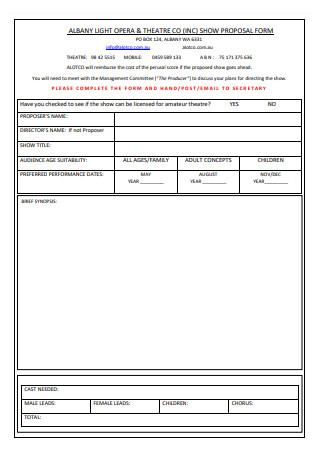
Theatre Show Proposal Form
download now -
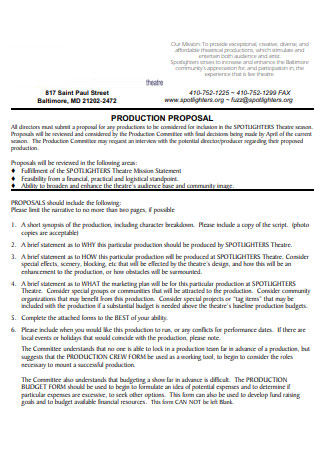
Theatre Production Proposal
download now -
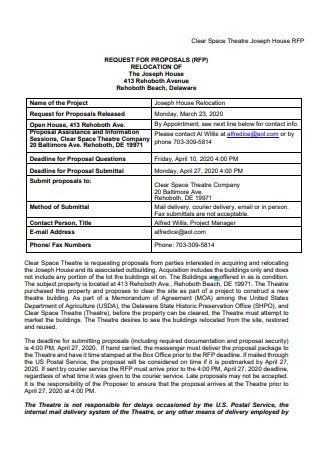
Basic Theatre Proposal
download now -

Theatre Proposal Example
download now -
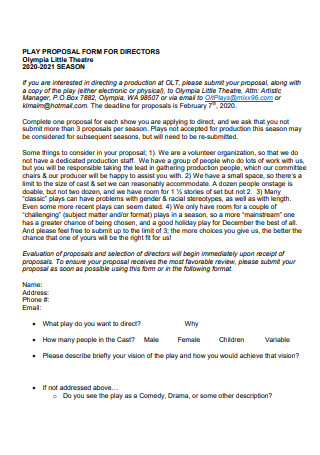
Theatre Directors Proposal Form
download now -
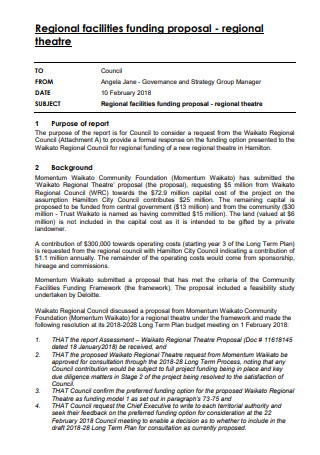
Regional Theatre Funding Proposal
download now
FREE Theatre Proposal s to Download
22+ Sample Theatre Proposal
What Is a Theatre Proposal?
Benefits of Theatre Proposals
Components of a Theatre Proposal
How To Create a Theatre Proposal
FAQs
What are the primary theatre genres?
What are the most important components of a proposal?
What role does theatre play in society?
What is the best way to develop a convincing proposal?
What Is a Theatre Proposal?
A play proposal, also known as a theatrical proposal, is a short document written in business language to obtain funding to produce a play. It follows the same framework as a book proposal or a business plan, but it is adapted expressly for the theatre sector. All aspiring playwrights, producers, and directors should be familiar with the process of writing a play proposal. Drama, according to statistics, aids in improving school attendance and lowering high school dropout rates. According to a 2005 Harris Poll, 93 percent of the population believes that the arts, particularly theatre, are essential for a well-rounded education. It can help children and youth with learning challenges improve their skills and academic performance.
Benefits of Theatre Proposals
Apart from persuading the reader to accept the proposed concept or plan for a particular theater play, it can also assist many novice stage directors and producers in gaining respect and recognition for their work, as well as increasing their exposure to prominent individuals, companies, and organizations in the entertainment and theater industries, particularly the general public. According to a statistics analysis released last year, from a total of 62,945 performances over the year, the figures reveal a combined audience of over 34 million people and ticket revenue of about £1.28 billion. Several advantages of utilizing a compelling theater proposal include the following:
Components of a Theatre Proposal
This part will teach you how to write a well-written theatrical proposal that will pique the interest of your proposal’s readers, including possible clients, investors, and funders. A proposal, on the other hand, comprises several parts. For a truly exceptional document, include the following elements:
Cover Letter
In a cover letter, the applicant’s qualifications and interest in the open position are outlined. Since the cover letter is one of only two documents sent to an employer, the quality of the letter will determine whether the applicant is invited to an interview. While the cover letter is a formal introduction written by the candidate, it also serves as a way for them to explain why they are a good fit for the position. As an extension of a resume, a good cover letter expands on items relevant to the situation. A sales pitch that explains why the applicant is the best person to fill the job. It’s better to customize each cover letter for the particular job than to use a generic message, and career experts advise job seekers. An applicant’s ability to stand out from the competition is greatly enhanced by putting in the extra effort.
Marketing Plan
A marketing plan is a record that shows an organization’s an advertising and marketing efforts for the upcoming year. It refers to the business activities necessary to achieve specific marketing objectives within a specified time frame. Additionally, a marketing plan includes:
- A description of a business’s current marketing position.
- A discussion of the target market.
- A description of the marketing mix used to accomplish the business’s marketing objectives.
A marketing plan follows a formal structure but can be used in either a formal or informal setting, making it highly adaptable. It includes historical data, forecasts for the future, and methods or strategies for achieving marketing objectives. Marketing plans begin by identifying customer needs through market research and determining how the business can meet these needs while still earning an acceptable profit. This encompasses market analysis, action plans, budgeting, sales forecasting, strategy formulation, and projected financial statements. A marketing plan can also be defined as a technique that assists a business in determining the most efficient use of its means to accomplish corporate goals. Additionally, it can include a comprehensive analysis of a company’s strengths and weaknesses, organizational structure, and products.
Resume
A resume is a formal document that reviews your professional qualifications, including relevant work experience, abilities, education, and noteworthy achievements. A resume, usually accompanied by a cover letter, helps you demonstrate your skills and persuade employers that you are qualified and hireable. Many job seekers believe that a resume’s function is to present a comprehensive picture of their professional experience. Instead, the purpose of your resume is to persuade companies that you are worthy of an interview. As a result, your resume is a valuable tool for highlighting your experience to potential employers. You will receive more interviews if your resume summarizes your relevant qualifications and skills in a format that makes your ability to manage the work as evident as feasible.
Financial Budget
In budgeting, a financial budget entails estimating the business’s long- and short-term income and expenses. Cash flow forecast that helps the company meets its objectives. The growth of a financial budget involves a detailed budget balance sheet, cash flow budget, and the business’s sources of income and expenses, among other things. Depending on the organization’s suitability, revenues and costs are evaluated monthly, quarterly, half-yearly, or annually. A financial budget is a highly effective instrument for achieving any company’s long-term objectives. It also keeps the shareholders and other members of the organization informed about the business’s operations.
Visual Arts
The visual arts include drawing, painting, sculpture, printmaking, design, crafts, photography, video, filmmaking, and architecture. These definitions should not be taken too literally, like many artistic disciplines (performing arts, conceptual art, and textile arts) incorporate visual and non-visual arts elements. Applied skills such as industrial design, graphic design, fashion design, interior design, and decorative art are also included in the visual arts.
Professionalism
Professionalism is defined as someone’s conduct, behavior, and attitude in a job or business setting. To display the essential abilities and characteristics, one does not need to work in a particular profession. Workplace success, a solid professional reputation, and a high level of work ethic and competence are all results of professionalism.
How To Create a Theatre Proposal
Create a complete and eye-catching theater proposal that will help you collaborate and participate with other aspiring theater play directors, producers, stage managers, scriptwriters, and artists in your neighborhood. In this case, we recommend that you choose one of the theater proposal templates and follow the simple steps below:
Step 1: Create an Eye-Catching Cover Letter
To begin, draft a brief and engaging cover letter. Explain your theatrical proposal’s core idea or theme and tell your reader about your professional experience in theater production. Define your theater play’s specific goals and objectives. Explain why your stage play is essential and meaningful, as well as why you are qualified to direct, produce, or design the production. Also, let them know when you want the theater production to take place.
Step 2: Determine who your target market is.
Determining the target audience of your stage play is one of the most important factors to consider when writing a good theater proposal. Set up a careful conversation with your drama and theater department or theater production crew about their thoughts, remarks, and suggestions for the theatrical endeavor. Conduct research into the target audience’s demands and preferences and the aspects of the stage play that they prefer to see. You’ll be able to develop new ideas or offer new concepts to your team this way. Then, discuss how the theater program would entice the audience.
Step 3: Include a synopsis of the theatre production.
Your proposal should include an agile overview of your theater project that is clear and interesting. Describe your unique ideas as well as the overall design of the theatrical play. It would help if you thought about your readers when writing this section. After that, include some reliable data.
Step 4: Provide a budget and a projected production schedule.
Create a rough estimate of the theater play’s financial budget that you’ll need to get the stage play off the ground. Indicate a breakdown of the theater play’s technological costs, theater production pieces, and other components. Then, include essential details about your theater program’s projected production timeframe. Provide exact dates for the completion of each stage of the theater production.
Step 5: Describe the key roles and responsibilities.
To define your theater group’s primary duties and responsibilities, create a concise and structured personal CV and background of individual key theater members such as the theater producer, stage director, and scriptwriter. Include resumes for your remaining theatrical crew, such as stage production managers, musical director, costume director, set designer, lighting director, sound designer, prop designer, and so on.
Step 6: Prepare a list of completed theater plays as examples.
The final section of your theater proposal is to gather some examples of your completed theater production plays related to the stage play you are currently working on. Attach some links or video clips from your online portfolio, website, business social media page, or shared cloud drive with some concise and clear descriptions of prior theater performances you’ve done.
FAQs
What are the primary theatre genres?
Comedy, tragedy, tragicomedy, and melodrama are the principal genres of theater plays. Comedy is a genre that focuses on making the audience laugh, with a lighthearted tale and a joyful ending. Murders, deaths, insanity, loneliness, and pain are all depicted in the tragedy genre. The term “tragicomedy” refers to a combination of tragedy and comedy. Melodrama is a film genre that seeks to arouse viewers’ emotions through archetypal tales.
What are the most important components of a proposal?
Technical, management, and financial budget are the three primary components of a proposal. The technical portion aims to persuade the reader that the service provider understands the client’s needs and has developed an innovative solution that can significantly benefit. The management section then describes the major activities and tasks, deliverables, project timetable, etc. On the other hand, the financial budget notifies the potential client of the project’s entire cost.
What role does theatre play in society?
Live theatre contributes to social conversation, dialogue, and the possibility of social change. Theatre is a cultural phenomenon that forces society to take a hard look in the mirror. We can look into societal issues and try to come up with answers. The community needs to come together and listen to competing viewpoints.
What is the best way to develop a convincing proposal?
You must have a precise understanding of and familiarity with your subject before drafting a persuasive proposal. Then, learn more about the tastes and demands of your target audience. Take your time to come up with ideas. Following that, compose the executive summary as well as the proposal’s substance. Remember to proofread and amend your document if necessary.
“Drama is exposure; it is confrontation; it is a contradiction, and it leads to analysis, construction, recognition, and eventually to an awakening of understanding,” said Peter Brooke. If you want to discover more about the collaborative support team that expounds on the wide range of opportunities and possibilities that might lead to a fulfilling career in theatre, you should know about them. Suppose you want to develop a Broadway-quality stage play. In that case, you’ll need to put in a lot of time and effort into creating vivid and stunning musical theatre plays, as well as the ability to write a clear and structured theatrical production plan. You may receive an accessible theatre proposal template right now to help you get started and achieve your dramatic production goals.
